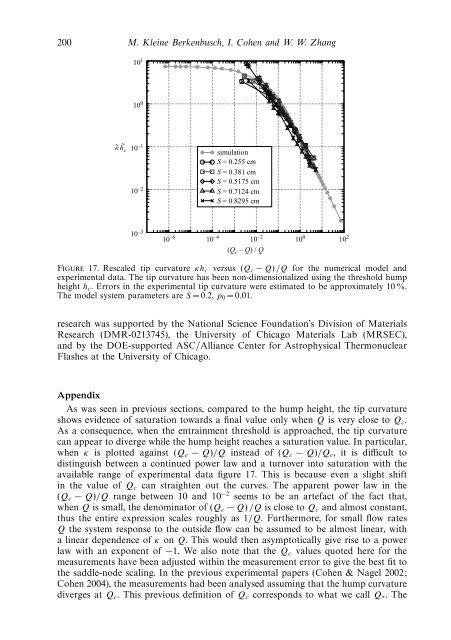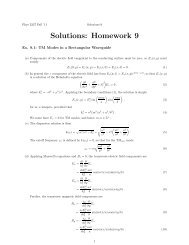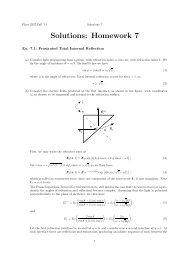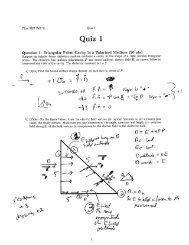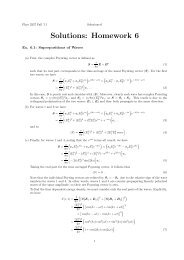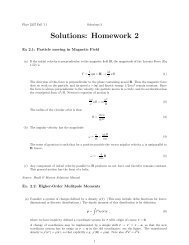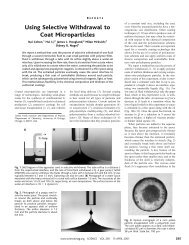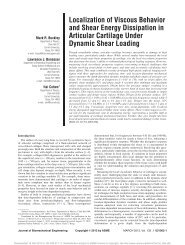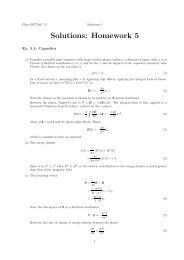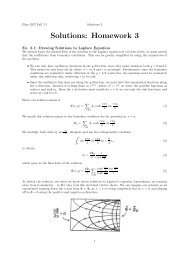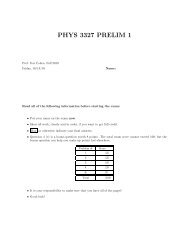<strong>Liquid</strong> <strong><strong>in</strong>terfaces</strong> <strong>in</strong> <strong>viscous</strong> stra<strong>in</strong><strong>in</strong>g <strong>flows</strong> 199of the natural log of (6.1) yields( ) κln = −β ln(1 − h ) (h= β + 1 ( ) 2 h+ ···). (6.2)C h ∗ h ∗ 2 h ∗When h c /h ∗ is sufficiently small, the higher-order terms are negligible, and we obta<strong>in</strong>a logarithmic relation between κ and h( κ) ( ) βhc hln =. (6.3)C h ∗ h cAccord<strong>in</strong>g to <strong>Cohen</strong> & Nagel, the s<strong>in</strong>gular shape is characterized by a scal<strong>in</strong>gexponent β between 0.75 and 0.82 (<strong>Cohen</strong> & Nagel 2002). In the long-wavelengthanalysis of spout formation, Zhang (2004) found that the steady-state spout shapeapproaches a s<strong>in</strong>gular conical shape. This would correspond to β = 1. Experimentaland scal<strong>in</strong>g analysis by Courrech du Pont & Eggers (2006) show that the cuspobserved <strong>in</strong> a <strong>viscous</strong> dra<strong>in</strong>age experiment approaches a conical shape, with β =1.Given these values, consistency requires that the coefficient βh c /h ∗ must be muchsmaller than 1, s<strong>in</strong>ce (6.3) is derived under the assumption that h c /h ∗ ≪ 1. We cancheck this aga<strong>in</strong>st the numerical results by fitt<strong>in</strong>g the calculated κ versus h curveswith the form( ) ( )κ hln = b , (6.4)κ 0 h cwhere κ 0 is the extrapolated <strong>in</strong>tercept at h =0andtheslopeb = βh c /h ∗ <strong>in</strong> (6.3). Fits tothe calculated curves for S =0.05, 0.2 and 50 yield, respectively, b values 5.5, 5.9 and1.9, all above 1. Consequently, h c /h ∗ is O(1) which <strong>in</strong>validates the Taylor expansion<strong>in</strong> (6.2). This clearly rules out the possibility that the logarithmic relation reflects theexistence of an isolated s<strong>in</strong>gular hump solution for equal-viscosity withdrawal.7. ConclusionsIn conclusion, we have created a simplified numerical model of selective withdrawaland shown that it captures the essence of the experiments. We f<strong>in</strong>d that the transitionfrom selective withdrawal to <strong>viscous</strong> entra<strong>in</strong>ment is discont<strong>in</strong>uous <strong>in</strong> the steadystate<strong>in</strong>terface shape, and shows similar features to saddle-node bifurcations <strong>in</strong> lowdimensionaldynamical systems. We also f<strong>in</strong>d that, when the <strong>in</strong>terface is significantlydeformed from the flat <strong>in</strong>terface, the hump curvature has a logarithmic dependenceon the hump height. We have tried to compare the selective withdrawal problem withother <strong>in</strong>terface deformation problems that attribute the logarithmic coupl<strong>in</strong>g to theexistence of a s<strong>in</strong>gular hump shape. None of the comparisons or proposed scenariosfully expla<strong>in</strong> the logarithmic coupl<strong>in</strong>g seen here. Although we do not understandwhy the surface evolves by hold<strong>in</strong>g its height nearly constant and allow<strong>in</strong>g its tipto become rather sharp, we have ruled out the possibility that this behaviour resultsfrom the existence of a steady-state s<strong>in</strong>gular hump for equal-viscosity withdrawal.Similar studies of selective withdrawal <strong>in</strong> which the fluid viscosities are varied willprobably help <strong>in</strong> resolv<strong>in</strong>g the issues raised by our <strong>in</strong>vestigations.We thank Sidney R. Nagel and Sarah Case for encouragement and helpful discussions.We also acknowledge helpful conversations with Francois Blanchette, Todd F.Dupont, Alfonso Ganan-Calvo, Leo P. Kadanoff, Robert D. Schroll, Laura Schmidt,Howard A. Stone, Thomas P. Witelski, Thomas A. Witten and Jason Wyman. This
200 M. Kle<strong>in</strong>e Berkenbusch, I. <strong>Cohen</strong> and W. W. Zhang~ h~ c10 110 010 –1simulationS = 0.255 cmS = 0.381 cmS = 0.5175 cm10 –2S = 0.7124 cmS = 0.8295 cm10 –310 –6 10 –4 10 –2 10 0 10 2(Q c – Q) / QFigure 17. Rescaled tip curvature κh c versus (Q c − Q) /Q for the numerical model andexperimental data. The tip curvature has been non-dimensionalized us<strong>in</strong>g the threshold humpheight h c . Errors <strong>in</strong> the experimental tip curvature were estimated to be approximately 10 %.The model system parameters are S =0.2, p 0 =0.01.research was supported by the National Science Foundation’s Division of MaterialsResearch (DMR-0213745), the University of Chicago Materials Lab (MRSEC),and by the DOE-supported ASC/Alliance Center for Astrophysical ThermonuclearFlashes at the University of Chicago.AppendixAs was seen <strong>in</strong> previous sections, compared to the hump height, the tip curvatureshows evidence of saturation towards a f<strong>in</strong>al value only when Q is very close to Q c .As a consequence, when the entra<strong>in</strong>ment threshold is approached, the tip curvaturecan appear to diverge while the hump height reaches a saturation value. In particular,when κ is plotted aga<strong>in</strong>st (Q c − Q)/Q <strong>in</strong>stead of (Q c − Q)/Q c , it is difficult todist<strong>in</strong>guish between a cont<strong>in</strong>ued power law and a turnover <strong>in</strong>to saturation with theavailable range of experimental data figure 17. This is because even a slight shift<strong>in</strong> the value of Q c can straighten out the curves. The apparent power law <strong>in</strong> the(Q c − Q)/Q range between 10 and 10 −2 seems to be an artefact of the fact that,when Q is small, the denom<strong>in</strong>ator of (Q c − Q) /Q is close to Q c and almost constant,thus the entire expression scales roughly as 1/Q. Furthermore, for small flow ratesQ the system response to the outside flow can be assumed to be almost l<strong>in</strong>ear, witha l<strong>in</strong>ear dependence of κ on Q. This would then asymptotically give rise to a powerlaw with an exponent of −1. We also note that the Q c values quoted here for themeasurements have been adjusted with<strong>in</strong> the measurement error to give the best fit tothe saddle-node scal<strong>in</strong>g. In the previous experimental papers (<strong>Cohen</strong> & Nagel 2002;<strong>Cohen</strong> 2004), the measurements had been analysed assum<strong>in</strong>g that the hump curvaturediverges at Q c . This previous def<strong>in</strong>ition of Q c corresponds to what we call Q ∗ .The


